Newton Highlands Historical Archive |
Index: The Old Hyde |
Public occasions in the Highlands often show residents glimpses of our past at exhibits at Brigham House, the Women's Club and elsewhere. This archive is an attempt to make this information available permanently via the World Wide Web. The material included here is typically original to the historical events that generated it. Therefore, it is not up to date to the present. Furthermore, much of it has no specific source attribution; thus its authors are anonymous.
The current content represents only a tiny fraction of the material that is available, but illustrates the idea. Anyone interested in contributing additional material (whether it be photographs, maps, text, reports, etc.) should feel free to contact Peter Szolovits. As of 2001, S. Nedeljkovic has created a web site similar to this one (and thus far based largely on it, with my delighted approval), as part of the official Newton Highlands Neighborhood Council web site. In addition, the Newton Free Library holds interesting collections of historical material, though not specifically about the Highlands. The Newton History Museum at the Jackson Homestead also holds relevant material and exhibits it though on-line exhibitions.
THE HYDE SCHOOL was named in honor of James F. C. Hyde, Newton's first mayor
and the man most responsible for Newton's incorporation as a city. A native of Newton Highlands, Hyde also served
on the School Committee and on the building committee for the first schoolhouse in the Highlands, a wooden building
completed in 1872 on the site of the present school parking lot. During its first year the new school had sixty-seven
students and two teachers, Only three years later, the School Committee report stated: 'It is earnestly hoped that
the city will sometime have the means and the disposition to remodel the building so that the large and pretentious
ugliness of its proportions may be modified in the interest of that education in good taste which a civilized community
is under moral obligation to supply by its public buildings.' In 1893 the city fulfilled this obligation by appropriating
$50,000 for a brick schoolhouse designed by Hartwell & Richardson of Boston, When it was dedicated in 1895,
there were eight teachers, and 321 students in kindergarten through ninth grade. Until the fire of April 25, 1981,
this was the oldest schoolhouse in Newton still used for its original purpose.
By 1902 the population of the Highlands had increased so greatly that the School Committee recommended 'that a new building be built in the Hyde district at once.' The new building was finally completed in 1908, when the student body numbered 461, with sixteen teachers. Only one feature was missing: a gymnasium. In 1895 the Superintendent had chided the citizens of Newton for not supporting physical education in the schools. He wrote: 'Sometime the more enlightened people who are to live after us will no more think of erecting a schoolhouse without a gymnasium than without the requisite number of recitation rooms.' In 1967 the Hyde gymnasium was built, and the school was complete.
SOURCE: The above description is from a broadside produced in 1981, with the following attribution: Two hundred and fifty copies of this broadside were printed in June, 1981, at the North River Press, by Amy Montague and four Hyde School students: Corrie Burchfiel, Paul Callanan, Marc Fraioli, and Carter Wright. We are grateful to the Jackson Homestead for permission to reproduce the illustration, and to Marjorie Searl for assistance in historical research. All profits from the sale of these broadsides will benefit the Hyde Fund.
A SUMMARY HISTORY OF THE
NEWTON HIGHLANDS BRANCH LIBRARY
MAY,1958
(An Open House celebrated opening of the Marion B. Morse Reasing Room at the Branch Library on May 11, 1958. See its program.)
At Newton Highlands the seventh branch or reading room was started in the new Hyde School in January, l908, with Miss Mabel Singleton in charge; a position which she held for thirty-nine years, or until her death in 1947. A book collection in her honor is placed in the present branch and has been added to each year by her sister Miss Elizabeth Singleton.
In l934 the former manual training room at the Hyde School was made available as a children's room and many thousand books have been circulated to Newton Highlands boys and girls from this room. Visits by classes from the school have been regularly featured during the principalship of Mr. Clarence E. Churchill.
In July, l946 the death of Mrs. Virginia M. Hutchinson, President of the Library Board occurred. Mrs. Hutchinson was library trustee for a period of twenty-four years end for seventeen of these years she was President. She was unusually well informed on public library matters in Massachusetts and especially in Newton and Newton Highlands. She was followed as woman representative on the Library Board by Mrs. James H. Zimmer and Mrs. George F. Brewer, both from Newton Highlands.
By 1951 the pressure for class room space at the Hyde School was very great and the Library Board was requested to seek other space for the adult library service of the Newton Highlands Branch Library. For some forty-two years adults had climbed the stairs to the branch in the school house. Although there was the awkwardness of being back from the street and on the second floor the use made of the library was constant. There was always the hope that Newton Highlands would have a new branch library building of its own. One group which had this thought in mind was the Chautauqua Literary and Scientific Circle of which Miss Marion B. Morse was a member.
After careful consideration of the possibilities for a new location for the library the City purchased the residence of Dr. Frederick S. Keith for many years a prominent physician of the Highlands. This Victorian type home was adapted for library use and had many advantages of convenience. The Newton Highlands Garden Club beautified the grounds with a planting including dogwood trees planted in memory of Miss Mabel A. Singleton and Miss Ethel Wiggen Skinner. Professor W. Northrop Morse planted a unique wild flower at the rear of the property. In 1956 the City built a public parking area between the branch library and the busi-ness center. This included use of the rear of the library property.
The Board of Library Trustees received in March, 1957 a bequest of $5000.00 as specified in the will of Marion B. Morse. After careful consideration, a plan for a reading room extension of the Newton Highlands Branch Library was made by Mr. Y. Cornell Appleton, architect of the addition to the Main Library, of the new Nonantum Branch Library, Boston architect and resident of Newton Centre. The Board of Aldermen appropriated $7000.00 which combined with the bequest to build the Marion B. Morse Reading Room. The successful bidder for the contract to erect the addition was Mr. Gerald A. Foley, a Newton Highlands contractor.
With the added space made available it was possible to move the children's library to the branch library at 20 Hartford Street where it had been operating during the summer months. The relationship of the Newton Highlands Branch to parking facilities, the school and the business center is a fortunate and practical one. The bequest of Marion B. Morse is another example of the citizen's interest and support which has given Newton ten active branch libraries.
Mike Zirpolo kindly contributed a handful of scanned photographs/postcards of the old Newton Highlands Post Office and other local scenes.

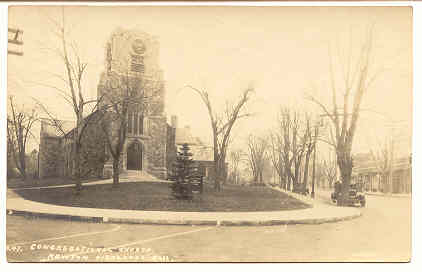
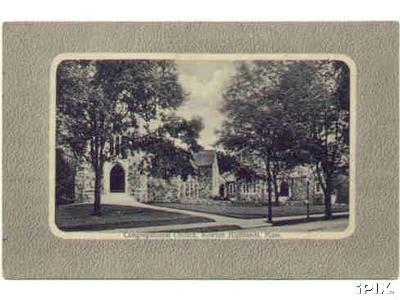
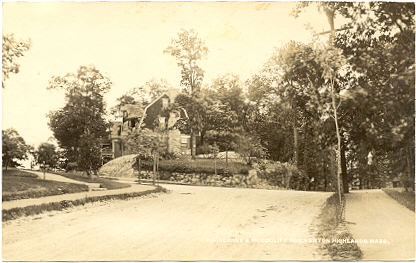
First is a photograph of Lincoln Street, with a streetcar. The Congregational Church is in the middle of the Highlands. It is visible in each of the first three photos. Fourth is a 1907 photograph of a scene at Rockledge and Woodcliff streets.
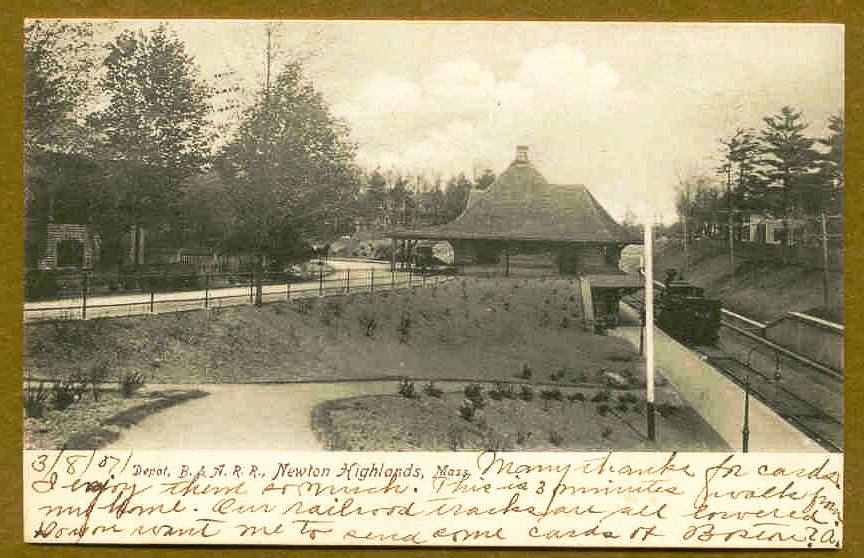
The Newton Highlands Railroad Depot, which is now the T stop.
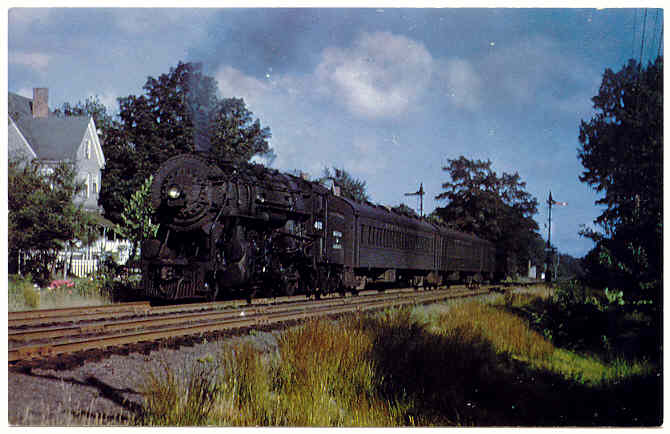
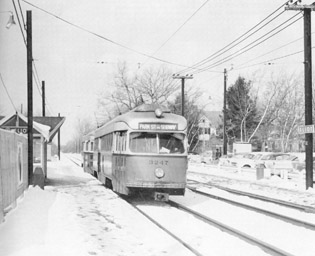
A train on the Highland Branch in 1948 and an old Green Line train inbound at Eliot Station.
Old Newton Highlands Post Office. Click on the photo to see two detailed enlargements. Mike believes, from an old map, that this Post Office was on Walnut Street, at or near 1155.
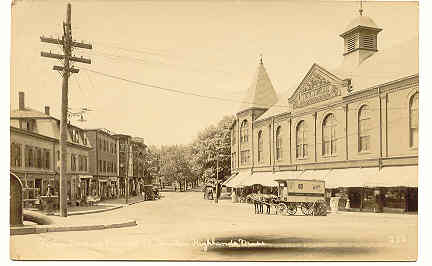
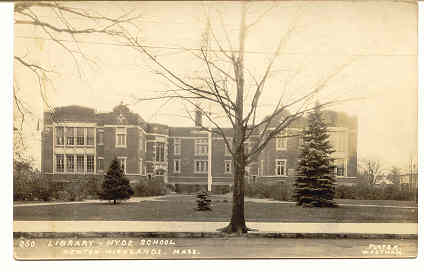


I have created a streetscape of the houses (and lots) along both sides of Lincoln Street starting from the Newton Highlands T stop to the Eliot T stop, running down the heart of the Highlands. Each thumbnail is linked to a larger (4 Mpixel) digital image. Some of these houses are described in the Newton Highlands house tour, but for most, I don't know much about their history.
Julie Bryan was kind enough to send me the following image by the artist John Elwell, along with a letter he sent in 1936, perhaps to another artist. Here is her note:
My mom bought this print a time back on Ebay, & she wanted me to sell it for her. I was doing research on this person & came across your site. I am enclosing some pics of this person’s plate printed on a note card & his letter inside to another artist perhaps. Was he critiquing his art? I don’t know but his name, address & sig is on this. You may use if you see fit. If you have any info on this person I would be curious.
Click on images below to see larger versions.
Just before Thanksgiving 2009, Marge McAvoy of the Sharon (Connecticut) Historical Society sent me the 1935-6 yearbook of the Newton Highlands Chautauqua Literary and Scientific Circle. (She was puzzled why it had been filed with 1903-4 Sharon Literary Club programs in her collection.) The C.L.S.C. is the oldest continuous book club in America, but I cannot tell how closely local clubs such as the Newton Highlands one were tied to the national book club.
The yearbook lists 23 active members, four associates, and 21 honorary members. Their meetings in Fall 1935 discussed overviews of modern Africa, organized by the colonial power ruling various sections. Winter meetings were devoted to recent literature, including biography, fiction, non-fiction, drama and poetry. The Spring focused on three great inventions: motion pictures, radio, and aviation.
Here are reproductions of the pages of the yearbook, and a link to a large sized pdf version. I have passed on the original to Susan Abele at The Jackson Homestead and Museum.





